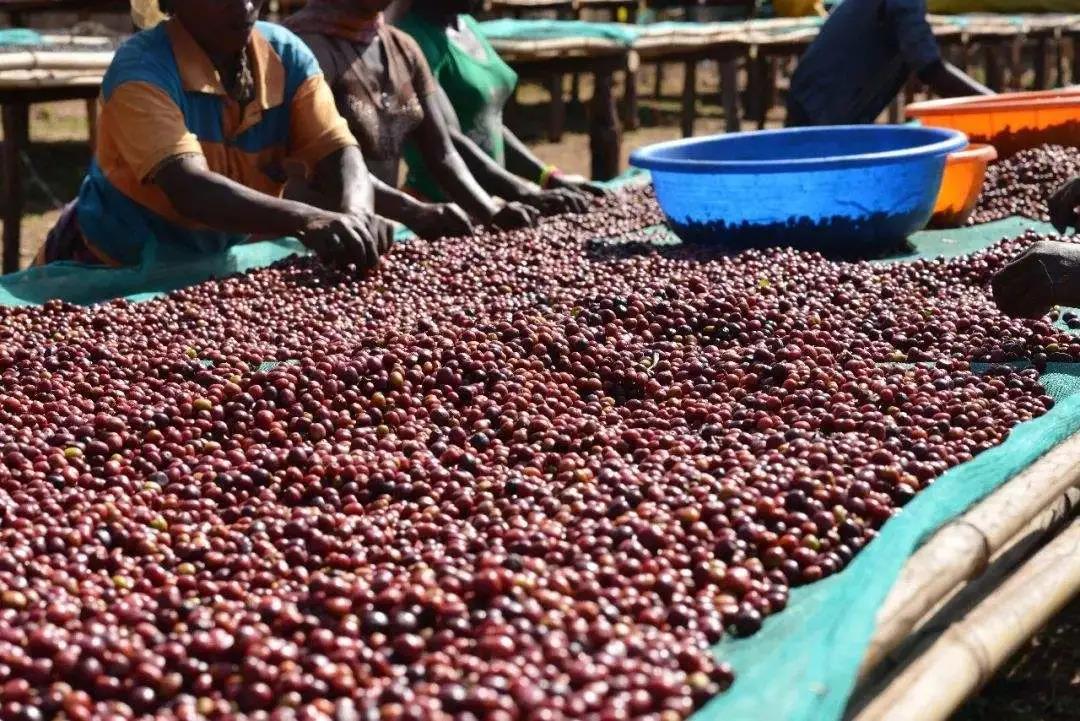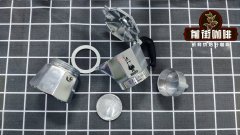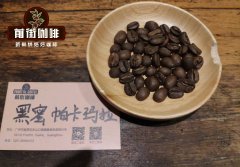How to brew Beloya coffee with the flavor of Yega Chefeld Coffee and Sidamo Coffee?
Professional coffee knowledge exchange more coffee bean information please follow the coffee workshop (Wechat official account cafe_style)
When it comes to the coffee-producing areas of Ethiopia, the famous Yegashifi and Sidamo always have a place in the hearts of coffee lovers. Qianjie Coffee tested the coffee beans in two producing areas and found that the coffee beans in Yega Xuefei have a faint floral fragrance, which gives the taste buds a feeling of freshness and cleanliness. The coffee beans in the Sidamo region give the taste buds a rich and full feeling, like a pile of compound fruits scrambling to release juice in the mouth.

So is there a bean that can drink two characteristics? Yes! Qianjie Cup tested a coffee bean from the Beloya region of Ethiopia and found that the coffee beans in this area have the floral aroma and citrus acidity of Yegashifi, as well as the fullness and fermentation of taste buds brought by the Sidamo region.
Beloya / Biloya coffee producing area
Beloya
When it comes to Beloya, we should first talk about the Cochelle producing area. Cochel is located in a small production area about 25 kilometers southeast of Yega Sheffield. The coffee beans are harvested from local small coffee farmers, which are composed of a large number of small coffee farmers with an average farming area of about 1 hectare and an altitude of about 1900-2000 meters above sea level. Cochel is part of Gaidio Gediyo in the Yirgacheffe of Yega Sheffield and is also one of the most important producing areas of Yirgacheffe.
The Beloya processing station is named after the town where the place name is Kore Biloya, which is located in the Cochelle region of the Yegashefi coffee region in the Gideo district. The coffee at the Biloya treatment station is picked and transported by 211 small farmers nearby. These coffees grow at high elevations of 1870-2100m.

The Biloya treatment station was built in 2001 and can handle nearly 1 million kilograms of coffee and cherries every year. The 138elevated drying beds in the treatment station cover an area of 2.5ha and cover a land area of 1700 square meters. The Biloya treatment station encourages farmers to bring the best coffee to the station to improve the quality of coffee by providing prizes and incentives to the farmers with the highest quality coffee.
Like most coffee growers in other parts of Ethiopia, coffee growers near Beloya grow coffee along with other crops such as bananas and corn. The hills and forests of the area are dense, and the unique trees provide a good shade to ensure the native species of Arabica planted here.
Coffee bean variety
Heirloom
This batch of coffee varieties are native to Ethiopia, and most Ethiopian varieties will be named after this name, in fact, because Ethiopia has too many varieties, it is like the natural gene bank of Arabica, on the one hand, there are many varieties, and it is difficult to identify and classify them, on the other hand, the Ethiopian government is unwilling to disclose the information of these varieties for the sake of protection, so it is collectively called "native species" (Heirloom).

Why are Essel's beans of different sizes? It is mentioned above that there are many varieties of coffee in Ethiopia, and coffee trees are all mixed. Qianjie calls this planting method natural blending here. The coffee beans produced by each variety of coffee trees have their own personality and size. When farmers harvest, they will be mixed and harvested, so there is a state of different sizes of coffee beans.
Coffee bean treatment
Nature
This batch of coffee uses the way of sun treatment and scaffolding to dry. During the harvest season (October to mid-January), when farmers bring fresh red fruits of coffee picked from trees to the cleaning station, they first have to visually check to make sure that each bag of coffee received is full of red fruit.

First of all, separate the coffee fruits sent to the cleaning station by hand to remove the defective coffee fruits with lower density. Then spread the qualified coffee fruit flat on the elevated drying bed for drying, which takes about 21 days. Dry the coffee fruit until the moisture content is about 12%. During the sun, Biloya's staff will check and remove overfermented and mold-infected coffee fruits, so every coffee bean is fine. Qianjie believes that the sun-treated coffee has obvious sweetness, soft acidity and more complex fruit tonality in flavor.

Country of origin: Ethiopia
Producing area: Yega Sheffield Kochel
Processing station: Biloya Beloya
Altitude: 1870-2100m
Variety: local native species Heirloom
Treatment method: sun treatment
Experience of coffee baking in Qianjie
In order to highlight the bright citrus berry acidity of Yega Chuefei coffee and the sweetness enhanced by sun treatment, Qianjie roasters roasted the beans to a medium-light level.

Yangjia 800N, bean 480g: furnace temperature to 165 degrees Celsius into the pot, throttle open 3, firepower 130. Temperature recovery point: 1 temperature 39% 32 ". The temperature rises to 115 degrees and the throttle opens 4. Bake to 5: 50 ", the temperature is 151.5 degrees, the bean surface turns yellow, the smell of grass disappears completely, and the dehydration is complete. When the bean surface appears ugly Hu wrinkles and black markings, the smell of toast obviously changes to the smell of coffee, which can be defined as a prelude to an explosion. At this time, it is necessary to listen carefully to the sound of the explosion point, starting at 915 ", the throttle is unchanged, and the firepower of 181 degrees is reduced to 90 degrees." the development time of an explosion is 1: 28 ", put into the pot at 195 degrees.
Coffee cup test report on Qianjie
Qianjie Coffee will be tested within 8-24 hours after the sample beans are roasted. Qianjie coffee makers generally use the cup test bowl capacity of 200ml ceramic bowl, which will be marked with 150ml and 200ml scale, according to SCAA standards, the TDS of water is about 150ppm, TDs is too low will easily cause over-extraction, too high will affect the taste and easy to lack of extraction, the cup measured the use of water temperature of 94 °. The cup test grinding degree according to the cup test standard of SCAA, the grinding degree is controlled as 20 standard screen (0.85mm), and the passing rate is 70% Mel 75%. Ratio: 11 grams of coffee powder plus 200 milliliters of hot water, that is, 1VR 18.18, so that the concentration of extraction happens to be within the range of 1.15% Murray 1.35% gold cup, soaking time: 4 minutes.

Dried incense: roasted almonds
Humidity: roses
Flavor: floral, citrus, strawberry, honey, jackfruit
Experience of brewing coffee in Qianjie
The suggestion for shallow baked beans is 90-91 ℃. The aroma and acidity of shallow baked beans can be extracted with higher water temperature, because the quality of shallow baked beans is hard, and increasing water temperature can increase the extraction efficiency of coffee powder and avoid unpleasant flavors such as acidity. The use of V60 tapered filter cup mouth is relatively large, coupled with its unique spiral curve ribs, so that the air can be discharged more easily so as to improve the extraction quality. The taste may not be thick enough, but its high concentration of sweet and sour and obvious aroma is a major feature of it.

Filter cup: V60 # 01
Powder content: 15g
Ratio of powder to water: 1:15
Degree of grinding: BG6m (pass rate of No. 20 screen is 80%)
Water temperature: 90-91 degrees

Qianjie coffee is extracted by stages, also known as three-stage brewing: steaming with 30 grams of water for 30 seconds, injecting water around a circle to 125 grams for stages, continuing to inject water to 225 grams when the water level is about to be exposed to the powder bed, removing the filter cup when the water level is about to be exposed to the powder bed, (steaming starting timing) the extraction time is 1 "3955"-2 "3900".
Cooking flavor: lavender aroma, rose, berry juice fullness, citrus acidity, honey, almond finish.
For more boutique coffee beans, please add private Qianjie coffee on Wechat. WeChat account: kaixinguoguo0925
Important Notice :
前街咖啡 FrontStreet Coffee has moved to new addredd:
FrontStreet Coffee Address: 315,Donghua East Road,GuangZhou
Tel:020 38364473
- Prev

How to use a mocha pot to make coffee? What kind of coffee grind does the mocha pot use?
The mocha pot is a symbol of Italian coffee culture and is one of the most famous brewing equipment in the world. Its iconic design, ease of use and wide availability make it an accessible entry point for special coffee. Although it is often used to make strong and full-bodied coffee at home, the moka pot actually has a wide range of uses. With a little experiment, home brewers can use it to explore specialty coffee.
- Next

The flavor characteristics of coffee in El Salvador introduce which coffee in El Salvador is the most famous.
El Salvador is the smallest and most densely populated country in Central America. It is also a world-renowned coffee producer. Coffee has been growing rapidly since the middle and late 19th century and has been an important contributor to El Salvador's economy for 100 years. However, coffee production in El Salvador has been declining since the 1980s and now accounts for less than 2 per cent of total exports. Still, it's now
Related
- Beginners will see the "Coffee pull flower" guide!
- What is the difference between ice blog purified milk and ordinary milk coffee?
- Why is the Philippines the largest producer of crops in Liberia?
- For coffee extraction, should the fine powder be retained?
- How does extracted espresso fill pressed powder? How much strength does it take to press the powder?
- How to make jasmine cold extract coffee? Is the jasmine + latte good?
- Will this little toy really make the coffee taste better? How does Lily Drip affect coffee extraction?
- Will the action of slapping the filter cup also affect coffee extraction?
- What's the difference between powder-to-water ratio and powder-to-liquid ratio?
- What is the Ethiopian local species? What does it have to do with Heirloom native species?

